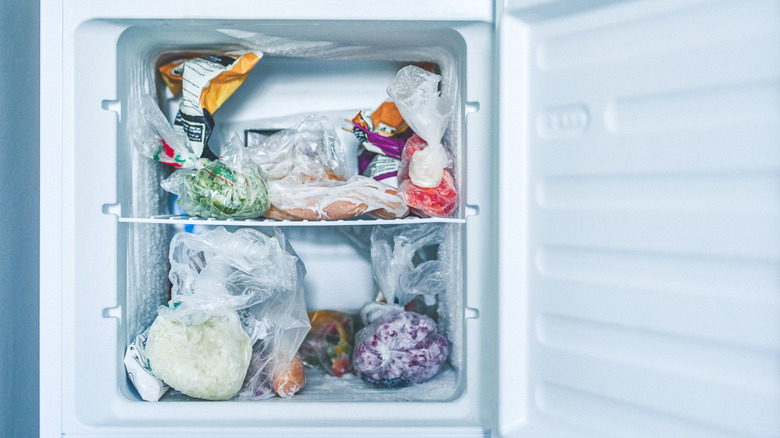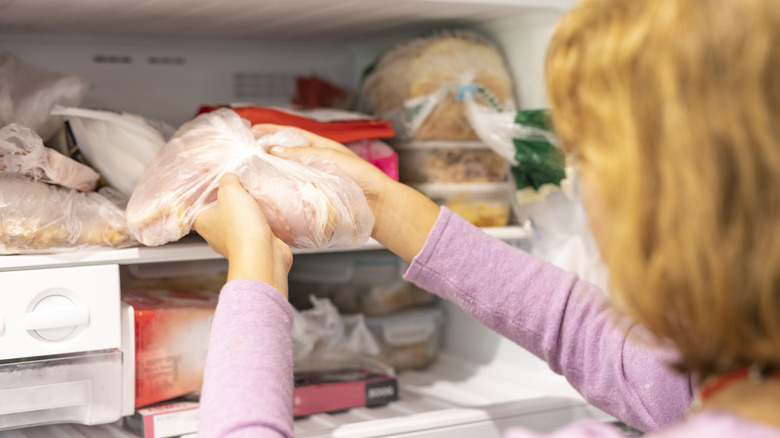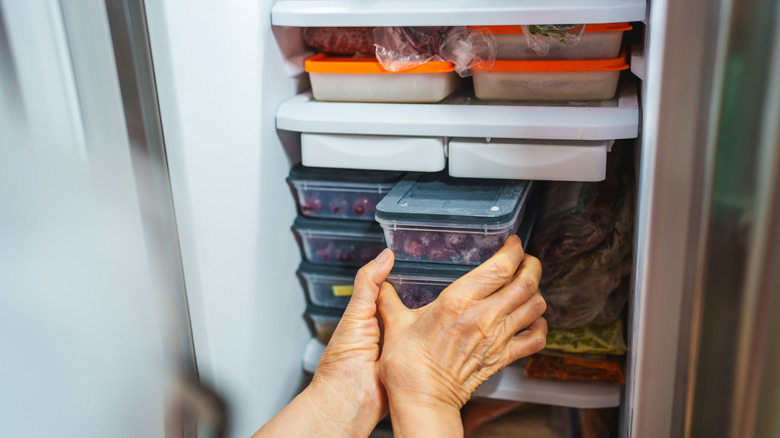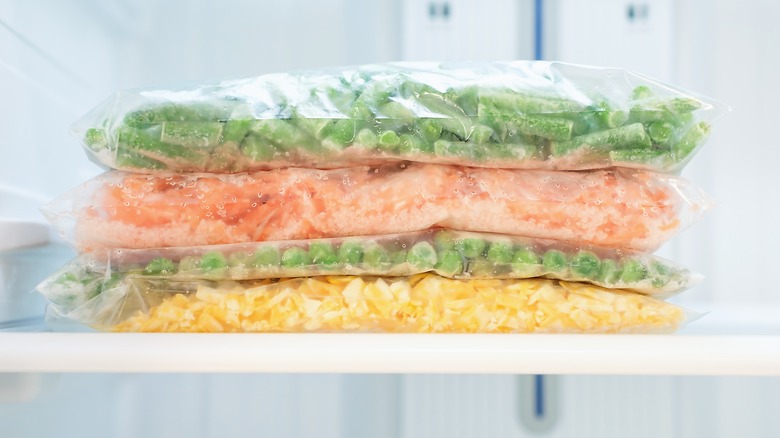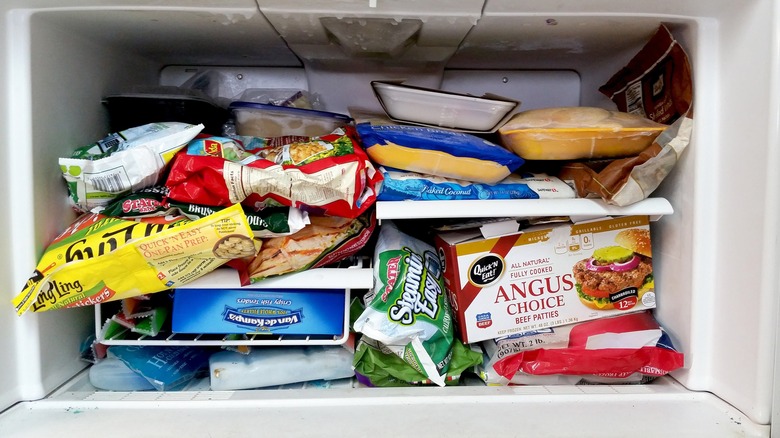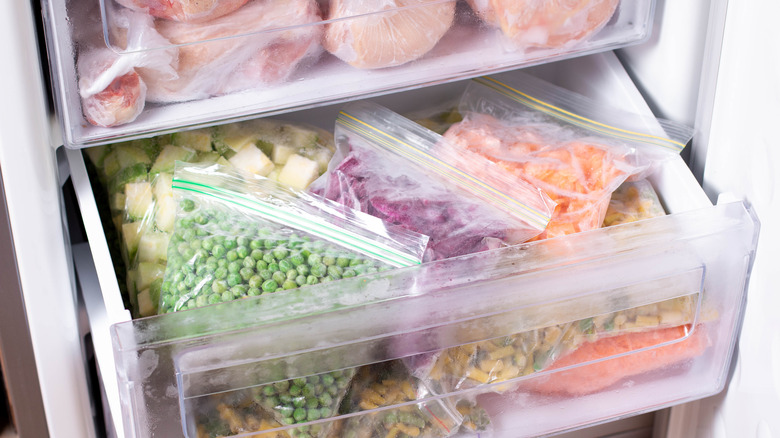5 Tips To Maximize Your Freezer Space Just In Time For The Holidays
The holiday season is underway — and so is the feasting, partying, and visiting with friends and family. Whether it's Diwali, Thanksgiving, Christmas, Hanukkah, Karamu Ya Imani, New Year's Eve, or office parties, there's going to be plenty of food up for grabs. It's the same if you're hosting or bringing home leftovers. Freezing some of your bounty is a great way to save money and enjoy delicious fare at a later date. The problem is finding additional space in already-tight quarters.
Instead of cramming leftovers willy-nilly into your full freezer, consider the start of the holiday season the perfect time to organize and maximize that precious long-term storage space. While re-stacking everything will open up some space, we've got a few more freezer hacks for efficiently storing food that will create enough room for any remaining roast or casserole. Just don't forget to label everything, including the date it went into deep freeze. This will help remind you what's actually in there, so it actually gets eaten. And if you're fortunate enough to have a refrigerator-freezer with a convertible drawer, consider shifting it to freezer mode during the holidays for extra storage space.
Take inventory and toss out the old for the new
The first step to maximizing your freezer space is finding out what's already inside and needs to go. Remove everything and set it on the counter. While most frozen foods last more or less indefinitely, their texture and quality can begin degrading within a few months. The USDA has a useful table for how long individual frozen items remain in peak condition. Check for expiration dates and evidence of freezer burn, which you can prevent with this storage tip. If something's been sitting in your freezer for a year, it's unlikely you're getting to it any time soon. Instead, clear it out for food you'll actually eat.
The same goes for those unusual or unidentifiable frozen foods. Perhaps there was once a great sale on pig's feet or you've got a quarter bag of ancient Brussels sprouts. If those no longer seem appealing, toss 'em. That unlabeled container filled with ... something from some party? Get it out of there. If you're on a restricted diet for any reason, throw out or give away all the items that don't fit your regimen.
When it's time to put the remaining items back, make sure the oldest stuff stays up front or on top so it gets used first. Note that everything you keep should be returned to the freezer before it fully thaws. If there are still visible ice crystals or the food feels very cold to the touch, it's good to go back into the freezer.
Use the right storage containers
It's easy to grab whatever container is available to freeze that leftover stew or last piece of lasagna. But all those different shapes and sizes wind up wasting a lot of space. Having uniform containers specifically designed for freezer storage provides two advantages: They stack compactly, maximizing available space, and they're designed to seal tightly, protecting against additional moisture or odors penetrating and potentially ruining food.
Freezer-safe glass containers work well, as do zip-top plastic bags that are designated as freezer bags. These are thicker and sturdier than your average resealable plastic bags, as they're made for longer-term storage. Note that some plastic containers can crack in the extreme cold. This storage mistake can ruin food, so make certain your containers are freezer-proof.
Look for containers that come in two or three different sizes, but still fit next to each other well. They should include either tight-fitting lids that press and seal into place, or have gasket seals and well-made snapping clamps. The 24-piece JoyFul storage system set from JoyJolt works nicely, but so do resealable plastic restaurant-style takeout containers, like this 50 pack from Dealusy (that's a lot of turkey and gravy). As an added bonus, once everything in your freezer is repackaged, you might find a half-dozen small bowls and containers that had mysteriously gone missing.
Freeze flat, store vertical
Your go-to freezing method may not be the best one. Tossing in bags of room-temperature fruit or meat straight from the store on top of a couple tubs of ice cream technically works, but this approach wastes space and can make everything harder to use later. When the items freeze, they will be uneven, lumpy, and a storage nightmare.
One unusual but efficient freezer trick is also one of the cheapest and simplest. Fill resealable plastic freezer bags with berries, leftovers, and even soups or stews. Seal them well, then lay them flat, either on an empty freezer shelf or baking sheet, and allow them to freeze overnight. You can use quart- or gallon-sized bags, depending on your preference. Again, make certain they are designed for freezer storage and label each one to know what's inside and when it went into the freezer.
If you have a large upright freezer, pull-out drawer, or chest freezer, store the packets vertically in a plastic bin, such as the Soho Collection from Bino, to save even more space. Then, when it's time to dig into your leftovers, just pull one bag up and out of the organizer like a file folder, replacing it later with the next frozen feast. Keeping a running inventory of what's in your frozen filing cabinet won't hurt either.
Repackage boxed items
A lot of ready-made frozen foods are boxed: waffles, ice pops, dumplings, and other treats. One easy way to free up some freezer space is to remove these items from their bulky boxes and store them on their own (if they're already wrapped), in zip-top freezer bags, or in your handy-dandy storage containers. This trick works best with items you use regularly rather than those intended for long-term storage (where the box helps protect from crushing as well as freezer burn). If you need the instructions, cut that part out of the box and include it in the freezer bag or tape it to the outside of the storage container.
This trick also helps with meat storage, by the way. Cookbook author Melissa Clark warns against freezing meat all wrong — that is, leaving it in the supermarket packaging. If you're tossing meat in the freezer straight from the store, you're doing it a disservice. The supermarket presentation, with its thin plastic wrap or butcher paper, is intended for short-term refrigeration. Putting it in the freezer as-is could lead to freezer burn, discoloration, or odor contamination from other foods. Instead, remove the meat from its tray and individually wrap each piece tightly in plastic wrap or freezer paper. Freeze them flat and nicely stacked to save space.
Incorporate frozen items into each meal
Even if you use the freezer primarily as a back-up pantry for lean times or snowstorms, the food is there to be eaten and enjoyed. To free up space, consider using something frozen daily, particularly when you're certain there's going to be an influx of new items (like during the holidays or when your favorite relative is about to stock you up with homemade goodies). Sometimes, we forget that the food in the freezer is available for any meal, not simply as a last-minute microwave dinner.
Whether that involves thawing a protein for your main dish, adding frozen berries to a smoothie, or finishing each dinner with a couple scoops of ice cream, consider this trick productive and not desperate. By regularly eating your frozen foods, you're efficiently using items rather than rediscovering them when they're past their prime and you're freeing up space. It's also a nice way to get inventive with your meals.
If you freeze individual foods, this is the best time to eat them. Pop that half-empty bag of frozen broccoli in the air fryer. Thaw a packet of chicken stock and use it for anything from cooking up pasta to searing a steak like Gordon Ramsay. When it comes to making fresh meals, incorporating frozen items like veggies can be as creative and enticing as digging through the spice cabinet. And that way, there will be room available for holiday leftovers.
